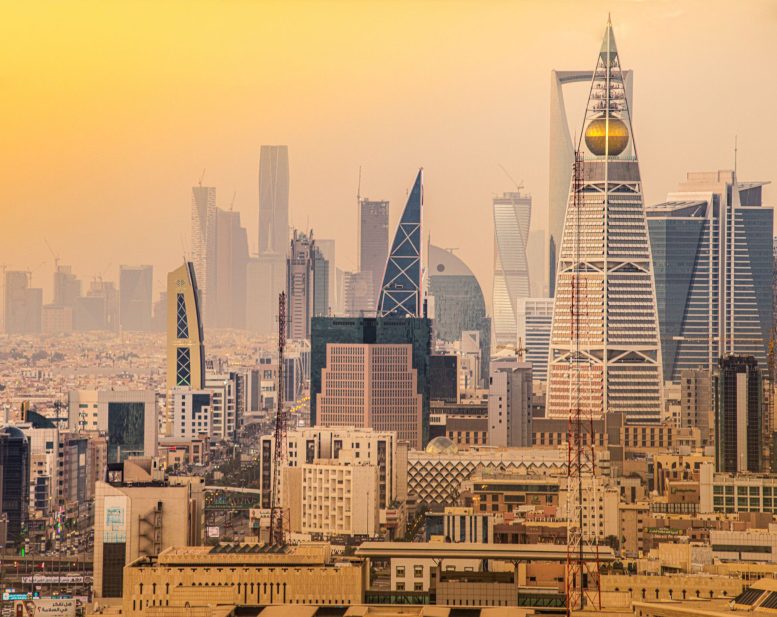
Research reveals that strategic implementation of cooling technologies in Riyadh can lower temperatures by 4.5°C and reduce energy demand, offering a sustainable solution to combat urban heat and enhance quality of life.
Employing a mix of cooling strategies and methods has the potential to lower both the temperature and energy requirements in Riyadh, Saudi Arabia.
A recent study from UNSW Sydney demonstrates that significant reductions in the temperatures of major cities located in hot desert climates can be achieved alongside decreases in energy expenses.
The findings, recently published in Nature Cities, detail a multi-faceted strategy to cool Saudi Arabia’s capital city by up to 4.5°C, combining highly reflective ‘super cool’ building materials developed by the High-Performance Architecture Lab with irrigated greenery and energy retrofitting measures. The study, which was conducted in collaboration with the Royal Commission of Riyadh, is the first to investigate the large-scale energy benefits of modern heat mitigation technologies when implemented in a city.
“The project demonstrates the tremendous impact advanced heat mitigation technologies and techniques can have to reduce urban overheating, decrease cooling needs, and improve lives,” says UNSW Scientia Professor Mattheos (Mat) Santamouris, Anita Lawrence Chair in High-Performance Architecture and senior author of the study.
Prof. Santamouris specializes in developing heat mitigation technologies and strategies to decrease urban temperatures in cities. Extreme urban heat affects more than 450 cities worldwide, increasing energy consumption needs and adversely impacting health, including heat-related illness and death.
Riyadh, the capital of Saudi Arabia, is one such city. Situated in the center of a desert, it is one of the hottest cities in the world, with temperatures that can exceed 50°C during summer. Furthermore, climate change and rapid urbanization are increasing the magnitude of overheating.
“Limited greenery and large artificial surfaces made of conventional building materials like asphalt and concrete trap heat, meaning the city continues to heat up,” says Prof. Santamouris. “Additional heat from car pollution and industrial activities also increases the city’s temperature.”
Simulating city-scale heat mitigation scenarios
For the study, the team led by UNSW researchers ran large-scale cooling climatic and energy simulations of the Al Masiaf precinct of Riyadh, including the energy performance of 3323 urban buildings, under eight different heat mitigation scenarios to evaluate optimal strategies for lowering the temperature of the city and reducing cooling needs.
The modeling, which considered different combinations of super cool materials, vegetation types, and energy retrofitting levels, found it’s possible to decrease the outdoor temperature in the city by nearly 8.1°F (4.5°C) during summer. The strategy would also improve cooling energy conservation for the city by up to 16 percent.
The recommended heat mitigation (or cooling) scenario for Riyadh includes using super cool materials implemented in the roof of the buildings and more than doubling the number of irrigated trees to improve transpiration cooling.
On the contrary, a blind implementation of urban cooling techniques not based on detailed and advanced scientific optimization, like the use of non-irrigated greenery, may result in a substantial increase in the city’s temperature.
“By implementing the right combination of advanced heat mitigation technologies and techniques, it is possible to decrease the ambient temperature at the precinct scale,” says Prof. Santamouris. “For a sweltering city the size of Riyadh, significantly reducing cooling needs is also tremendous for sustainability.”
Prof. Santamouris says lowering the temperature of the city helps increase thermal comfort for people as well as reduce health issues from severe heat, decrease the concentration of pollutants, and improve human productivity. While not a part of this study, previous research found implementing similar cooling strategies in other cities can help reduce heat-related deaths.
Reducing energy demand at the urban scale
The research also simulated the energy impact of retrofitting measures for all 3323 buildings, alongside heat mitigation technologies implemented at the urban scale. Combining the optimal cooling technologies with energy retrofitting options – namely, improving the building envelope through better windows, insulation, solar and cool roofs – could decrease the cooling demand by up to 35 percent.
“This represents a substantial reduction to the energy needs for Riyadh that would help further reduce costs associated with cooling for the city while improving the quality of life for the local population,” says Prof. Santamouris.
The researchers now hope to work with the Royal Commission of Riyadh to begin implementing the tailored heat mitigation plan in the city, which would be the largest of its kind in the world.
“Once implemented at the city scale, these advanced heat mitigation technologies will deliver important health, sustainability, and economic outcomes for the city for years to come,” says Prof. Santamouris.
Reference: “Quantifying the energy impact of heat mitigation technologies at the urban scale” by Shamila Haddad, Wanni Zhang, Riccardo Paolini, Kai Gao, Muzahim Altheeb, Abdulrahman Al Mogirah, Abdullatif Bin Moammar, Tianzhen Hong, Ansar Khan, Constantinos Cartalis, Anastasios Polydoros and Mattheos Santamouris, 11 January 2024, Nature Cities.
DOI: 10.1038/s44284-023-00005-5
The research team also included researchers from the University of Sydney, Lawrence Berkeley National Laboratory, the Royal Commission of Riyadh City, the University of Calcutta, and the University of Athens.
>>> Read full article>>>
Copyright for syndicated content belongs to the linked Source : SciTechDaily – https://scitechdaily.com/scientists-develop-method-to-cool-one-of-the-worlds-hottest-cities-by-8f/